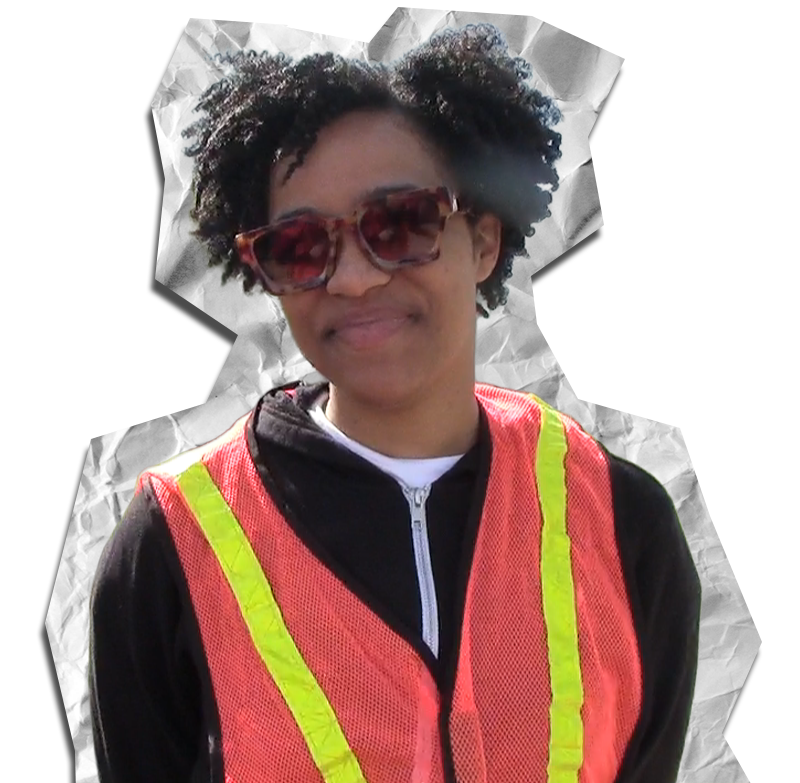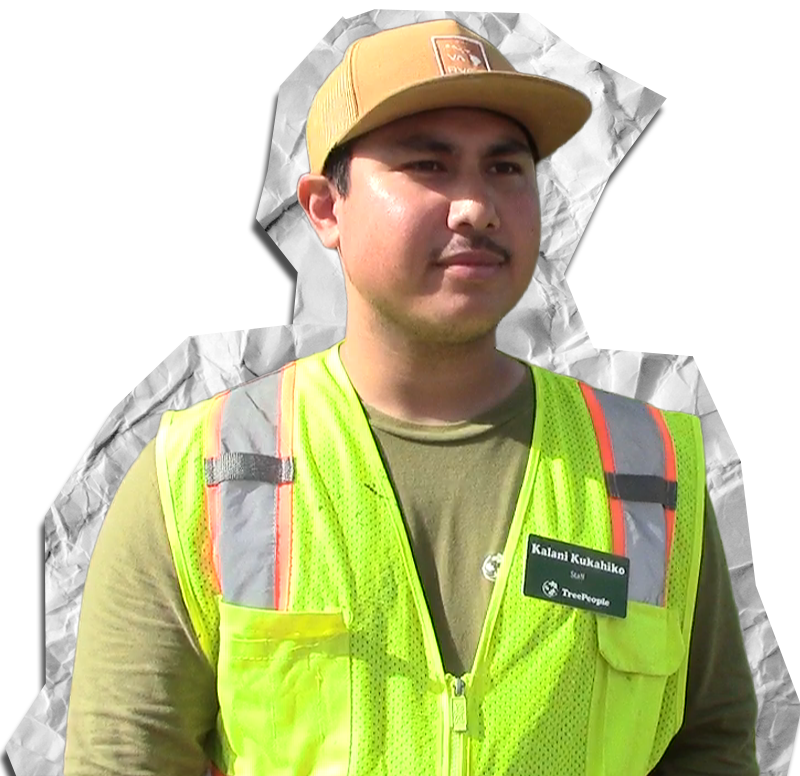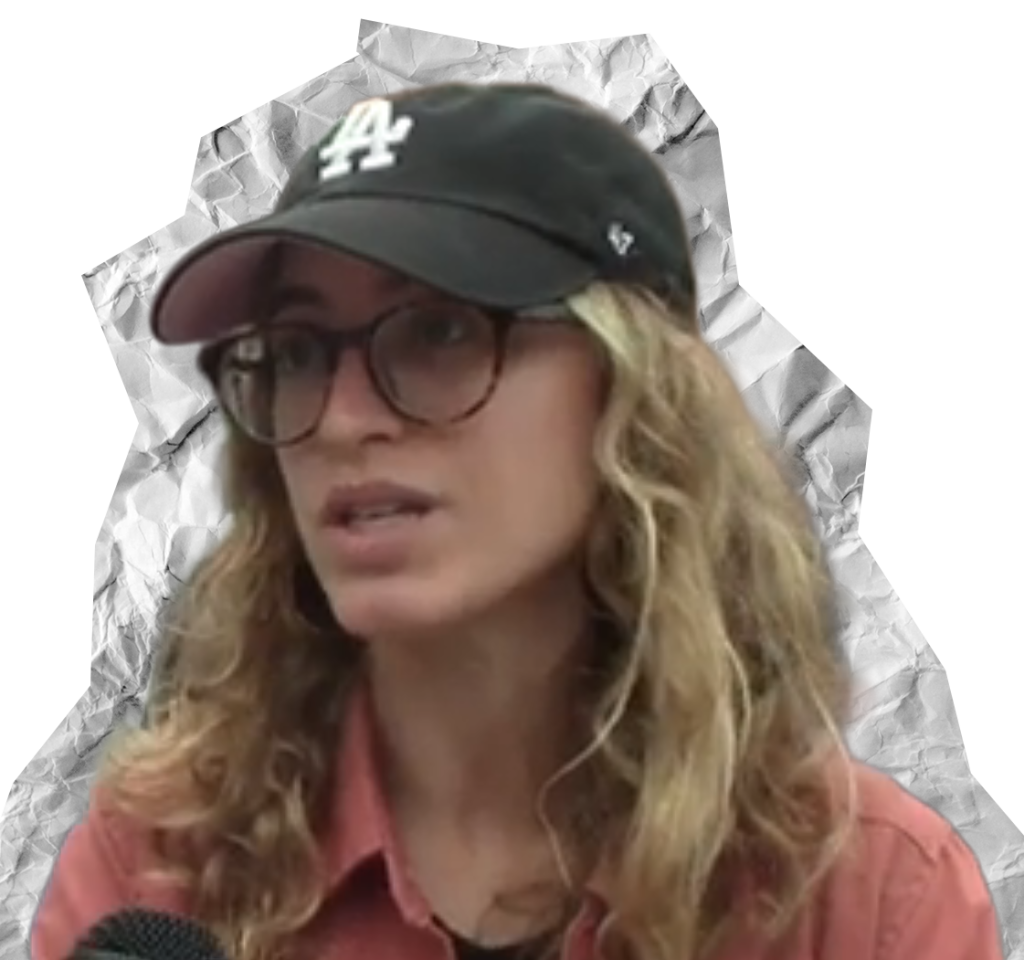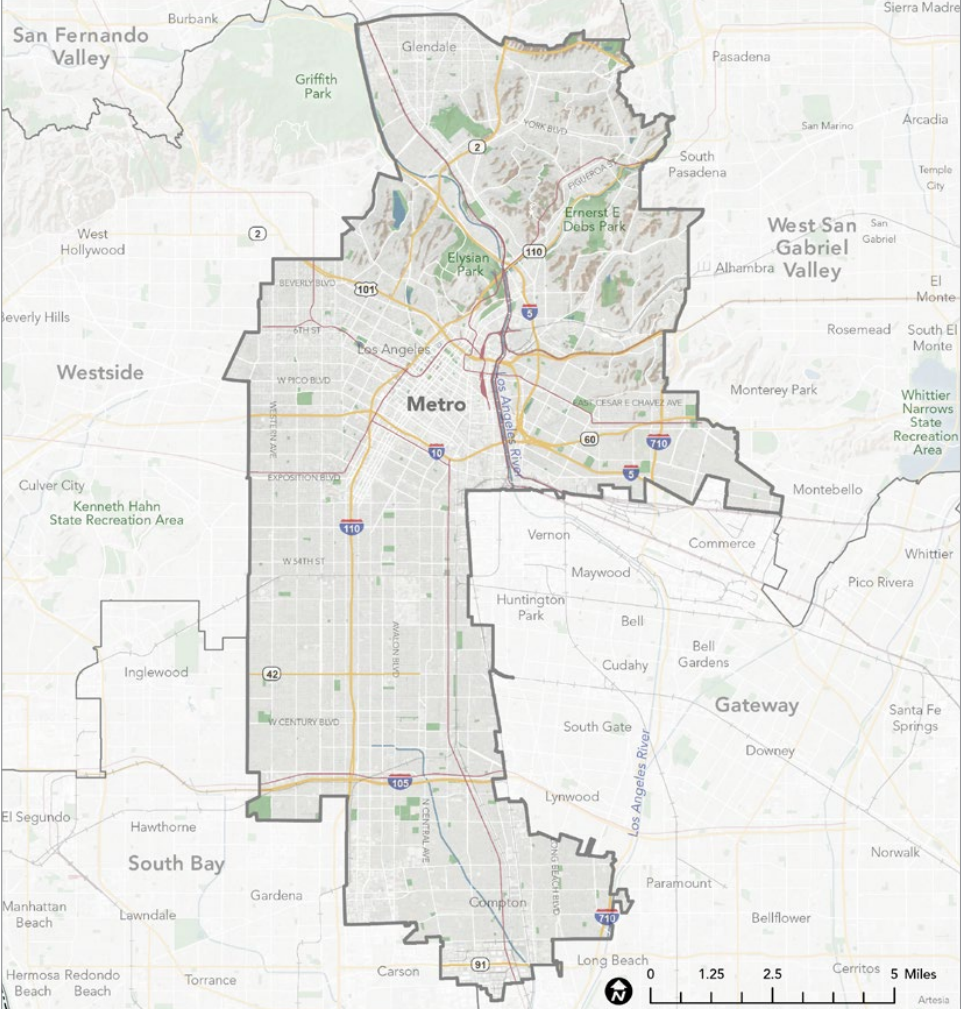Thousands of trees may go unplanted in Los Angeles as TreePeople faces budget woes
By: Quinten Seghers

HR worker
On a sunny Saturday morning, dozens of local volunteers donned bright orange garb, fastened their white helmets and carried stacks of plastic buckets as they walked along Bristow Park and through the neighboring streets of Commerce, a city in southeast Los Angeles County. Newly acquainted with the core tenets of “tree care,” they began working their way down the street going from sapling to sapling.
The volunteers removed weeds, added mulch and inspected the saplings’ supportive stakes whilst attempting to avoid oncoming traffic. In five to 10 years, Commerce residents will be able to enjoy the shade of blooming pink crape myrtles, Brisbane boxes, African sumacs and more.
“These are babies, they’re going to be little trees for a very long time, they’re going to be skinny sticks,” said Lezlee Williams, a human resources worker and one of the event volunteers. “But I get to come back when I’m older and just see how they’ve grown and just know that I’ve been a part of that.”
But this event was never meant to be.
A flurry of executive orders
While funding cuts to the United States Agency for International Development, the National Institute of Health and the Internal Revenue Service have dominated headlines, there are other, less frequently discussed cuts that will drastically impact what America looks like on a neighborhood by neighborhood, and even street by street basis.
In section seven of President Trump’s Unleashing American Energy executive order, issued on the first day of his second term in office, the “Green New Deal” was declared “terminated.” Section seven, among other things, paused the distribution of funds from the Inflation Reduction Act. Originally hailed as a “breakthrough” by environmental groups, the IRA was estimated to cut national net greenhouse gas emissions by about 40% by 2030 were it fully implemented, according to the Rhodium Group. It would have done so, in part, by financially supporting urban tree planting.
Today, there are few issues left that garner broad bipartisan support: adopting a hawkish stance on China, supporting veterans and, by an overwhelming margin, planting trees.
Pew Research polling conducted in 2024 found that 89% of Republicans and 91% of Democrats approve of “planting about a trillion trees to absorb carbon emissions.” No other climate policy polled nearly as high.
However, Trump’s executive order stipulated zero exceptions to the pausing of IRA funding distribution.
TreePeople faces funding cuts, uncertainty
TreePeople, the organization that hosted the Bristow Park tree care event, is one of the largest environmental organizations in Southern California. TreePeople has planted over three million trees since its inception over 50 years ago, according to Bryan Vejar, TreePeople’s director of community forestry.

South Los Angeles community forestry coordinator at TreePeople

Director of community forestry
at TreePeople
The organization oversees Coldwater Canyon Park, organizes educational activities for school children and hosts community forestry programming — just to name a few responsibilities. During community forestry events, TreePeople employees teach volunteers all the necessary steps to plant urban trees or how to perform tree care. Then, those skills are immediately put to the test. In 2023, TreePeople planted nearly 9,000 trees with the help of its volunteers.
The signing of the Unleashing American Energy executive order immediately injected uncertainty among environmental nonprofits as they were not sure whether they would still receive their federal grant funding. TreePeople responded by temporarily pausing all its projects that were fully or partially funded by the federal government.
“It would be catastrophic for us to move forward and spend down money when we’re not absolutely certain that we’ll receive compensation for those federally allocated funds that were previously congressionally approved,” Vejar said.
“Unfortunately, environmental programs kinda get pushed toward the bottom of the totem pole when it comes to government.”
-Kalani Kukahiko
“It would be catastrophic for us to move forward and spend down money when we’re not absolutely certain that we’ll receive compensation for those federally allocated funds that were previously congressionally approved.”
-Bryan Vejar
On March 31, TreePeople conducted an “internal reassessment” of its federal funding situation and all its federal grants were deemed to be on “indefinite hold.” Only planting operations funded by other sources will continue, according to Loren Feder, the Teams for Trees program manager at TreePeople.
“Unfortunately, environmental programs kinda get pushed toward the bottom of the totem pole when it comes to government,” said Kalani Kukahiko, TreePeople’s South Los Angeles community forestry coordinator.
Vejar said receiving a federal grant is not as simple as the government writing a check. Instead, TreePeople has to engage in “extensive reporting” by providing billing information, invoices, staff reports and more to qualify for reimbursements.

Cal State LA foreign exchange student
“Environmental justice is social justice and we work in areas that have been historically underserved, and many of those areas are in historically [Black, Indigenous and People of Color] communities. Unfortunately, many of our operations and funding associated with these operations are in the crosshairs of the executive orders.”
-Bryan Vejar
At the start of the year, dozens of trees were slated to be planted on Feb. 22 in the city of Vernon, an industrial area located near South LA. However, in response to the funding distribution pause, TreePeople underwent organizational restructuring and has shifted its focus to tree care, according to Montserrat Plascencia, TreePeople’s regional manager for southeast and South LA. Days after Trump signed the Unleashing American Energy executive order, the Vernon tree planting event was cancelled and replaced by the Bristow Park tree care event.
“Environmental justice is social justice,” Vejar said. “We work in areas that have been historically underserved, and many of those areas are in historically [Black, Indigenous and People of Color] communities. Unfortunately, many of our operations and funding associated with these operations are in the crosshairs of the executive orders.”
Most of the Bristow Park volunteers were unaware of the event’s alteration from a tree planting to a tree care event, but many said they were still grateful for the experience.
“I feel like I’m [becoming] a better person for doing this,” said Kang San Keum, a South Korean foreign exchange student at Cal State LA. “I just wanted to make friends … I hope I can do [tree care] again when I go back to Korea as well … We should have more trees [in Korea].”
Planting trees: a ‘double-edged sword?’
Research from USC’s Urban Trees Initiative — a part of Dornsife Public Exchange — has found that underserved neighborhoods in LA such as South LA, Lincoln Heights, El Sereno and Ramona Gardens have less access to green space and have a smaller urban tree canopy compared to more affluent neighborhoods.

Senior project manager at
Dornsife Public Exchange

Los Angeles County Park Needs Assessment Plus Report
“Urban tree canopy has a serious equity issue in Los Angeles,” said Marianna Babboni, a senior project manager at Dornsife Public Exchange. “Only wealthier affluent neighborhoods experience really robust urban tree canopy that shade and protect our residents from extreme heat as temperatures rise in Los Angeles.”
Los Angeles County conducted its own research on the issue, releasing an updated version of its Park Needs Assessment Plus report in 2022. In the report, the Los Angeles County Department of Parks and Recreation mapped out all green space in the county.
The “Metro” study area, which stretches from Compton to Glendale, lists only one nature-based recreation area south of Interstate 10 — Exposition Park. While the park spans 160 acres, significant portions are occupied by the LA Memorial Coliseum, BMO Stadium, a school, multiple museums and parking lots.
Only 5% of the Metro study area’s population lives within walking distance — defined as half a mile — of a nature-based recreational area, according to the county report.
Trees are one of the best ways to cool down streets and build more resilient neighborhoods, according to Babboni.
“There are so many co-benefits to [having] trees in our public right of way,” Babboni said. “Shading our sidewalks, cooling our ambient air temperatures, making conditions more livable for residents on those streets.”

Earth science professor at Dornsife
Trees are particularly powerful tools for clamping down on carbon emissions. A February study from Dornsife Public Exchange revealed trees are capable of absorbing more carbon dioxide than previously estimated.
“The trees in LA are growing, like kind of super happy trees. They’re not dying, they’re growing and they’re taking up a lot of CO₂ and they’re making an impact overall on how much CO₂ is in LA.”
-Will Berelson
“The trees in LA are growing, like kind of super happy trees,” said Will Berelson, an earth science professor at Dornsife and one of the study authors. “They’re not dying, they’re growing and they’re taking up a lot of CO₂ and they’re making an impact overall on how much CO₂ is in LA.”
Berelson said one has to pay attention to the specific tree species planted, as not all trees are as effective at absorbing CO₂ and that planting trees can be a “double-edged sword.”
That’s because trees naturally produce volatile organic compounds, which are compounds that, once released, can turn into ozone — a type of pollutant. VOCs can also make compounds that turn into other types of particulate matter, according to Berelson.
“Trees can make [particulate matter] and trees can also consume [particulate matter], so they’re kinda funny, they can go both ways,” Berelson said.
Taking care of trees amid a changing landscape
“We’re trying to plan and pivot and make sure that our staff is supported and that we’re continuing to come through for our communities. But yeah, it’s been a tough year with the fires and now the budget freeze.”
-Bryan Vejar
The TreePeople Land Trust — a separate legal entity from TreePeople, though some staff members work in both organizations — oversees more than 3,000 acres in the Santa Monica Mountains. While areas under either organization’s purview weren’t directly impacted by the January LA wildfires that burnt over 40,000 acres, the high winds that accompanied the fires were still destructive, with many newly planted trees being uprooted.
The fact that the LA wildfires and the chaos surrounding the federal funding freezes occurred within the same month caused turmoil for TreePeople, according to Vejar.
“We have separate challenges, both environmental challenges, operational challenges, political challenges and we’ve stayed strong. We’ve grown just like a tree; trees grow stronger when they are tested.”
-Bryan Vejar
“We’re trying to plan and pivot and make sure that our staff is supported and that we’re continuing to come through for our communities,” Vejar said. “But yeah, it’s been a tough year with the fires and now the budget freeze.”
According to Vejar, TreePeople has had to pause partnerships with various nonprofits, cancel contracts with their supply chain partners and adjust where they deploy their truck fleet.
“We have separate challenges, both environmental challenges, operational challenges, political challenges and we’ve stayed strong. We’ve grown just like a tree; trees grow stronger when they are tested,” Vejar said.
Explore the trees behind TreePeople
Kukahiko said climate change has made it harder for native trees to survive in LA, prompting TreePeople to plant a variety of “climate champion” tree species. These trees, which hail from all over the world, all share one key trait — they’re drought tolerant.
Click through to learn more about the trees volunteers cared for at the Feb. 22 Bristow Park tree care event in Commerce and why these species are being planted across the Greater Los Angeles area.